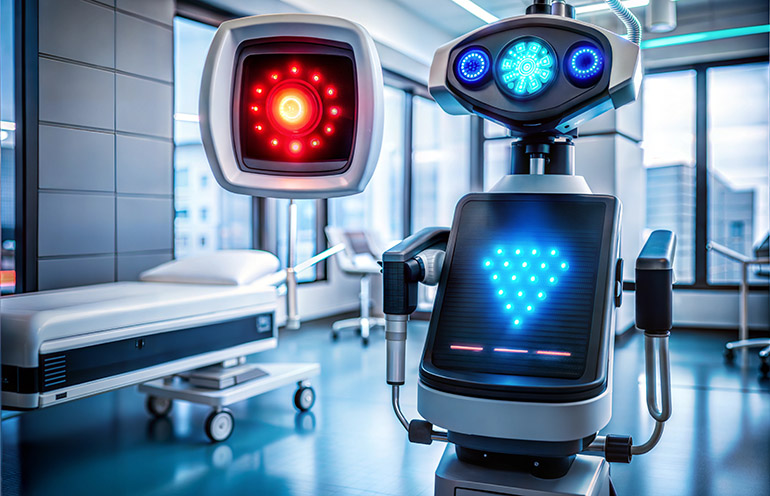
Robotic companions are spreading in healthcare settings, according to Research Nester. Credit: Adobe Stock
Back in 1985, a robot named PUMA 560 conducted a stereotactic brain biopsy with 0.05 mm accuracy. This began the introduction of robots in the healthcare system for performing various functions.
The demand for healthcare robots mushroomed since the COVID-19 pandemic. Research Nester has estimated that the market for medical robots increased by 36.5% to around 6,100 units in 2023.
In addition, sales of rehabilitation and non-invasive therapy robots grew by almost 128%. The robots have become companions for healthcare staffers, and the market is booming with opportunities. Let’s examine why numerous companies are willing to invest in this market.
Healthcare robots already on duty in hospitals
Robotics has an array of applications in hospitals. For instance, the robotic-assisted surgery market could reach more than $14 billion (U.S.) by 2026. Here are some of the prominent tasks for which robots are being used in hospitals:
Telepresence: The Sanbot Elf robot was designed to provide a remote presence for visiting families, co-workers, hospital patients and efficaciously. During the pandemic, Ava Robotics‘ systems helped doctors see more patients while avoiding infections.
Surgical assistants: Millions of procedures are carried out each year with robotic assistance, and over the past 20 years, over 12 million were performed with Intuitive Surgical‘s da Vinci systems alone. Some of the prominent surgeries that can be done with the help of robots are:
- Colorectal
- General surgery
- Gastric bypass
- Robotic-assisted laparoscopy
- Cholecystectomy
- Kidney transplantation
In addition, by 2030, more than 700,100 robotic-assisted knee reconstruction procedures could be performed globally.
Medical transportation: Unlimited Robotics offers Gary, which it designed to address numerous logistical challenges faced by modern hospitals. Mobile robots can improve operations in the following ways:
- Improved efficiency: 26% to 30% reduction in wait times for supply deliveries and patient transfers
- Time savings: 100 to 180 staff hours could be saved daily
- Cost savings: A facility’s labor costs could be reduced by $876,100 to $1 million annually
- Staff satisfaction: 5% to 10% reduction in turnover rates due to decreased non-clinical workload
Sanitation and disinfection robots: With the rise in antibiotic resistance, healthcare facilities are using robots to clean surfaces. Ultraviolet disinfection robots are widely used to enhance manual cleaning.
Robots enter nursing homes and elder-care centers
The PARO robotic seal is an example of an interactive care robot particularly fabricated for older individuals suffering from dementia. These therapeutic robots provide emotional support and companionship to alleviate loneliness and anxiety.
Some of the prominent activities performed by robots such as PARO, Tombot’s Jennie, and Intuition Robotics’ ElliQ are:
- Assisting with daily activities
- Increasing mobility and independence for older adults
- Preventing accidents and detecting falls
- Rehabilitation and cognitive training
- Medication reminders
According to the National Institutes of Health, the average implementation cost of a robot is almost $85,000 per year, but the cost of hiring human caregivers is higher than this.
Surveying the landscape for healthcare companion robots
Research Nester estimates that the companion robot market will garner $1 billion by the end of 2024, and it could reach $11 billion by the end of 2037. Some of the growth-propelling factors for the market are:
- Increasing demand for home assistance for the aging population
- Rising inculcation of automation
- Rising need to help the differently-abled population
- Increasing initiatives from the government supporting healthcare robots
- Robot companions aiding the cognitive and emotional development of children
However, factors such as the high cost of production and privacy challenges are some of the growth restraining factors for the growth of the healthcare companion robots market.
Some of the companies making a positive impact are Aeolus Robotics, Andromeda, ASUSTeK Computer, Blue Frog Robotics, inGen Dynamics, Luvozo, PAL Robotics, and UBTECH.
We project that North America will experience the most promising growth rate, with rising demand for humanoid robots in hospitals. For instance, Aethon’s Zena RX can securely deliver pharmacy and other clinical materials day or night.

The healthcare companion robotics market is expected to grow from 2024 to 2037. Source: Research Nester
The above discussion shows that the healthcare robotics market is offering lucrative growth opportunities. Entrepreneurs and practitioners are willing to make investments to serve this market.
However, getting appropriate knowledge of the market parameters is of utmost importance with cutting-edge technologies in a competitive world. Market research reports offer detailed analyses of growth drivers and constraints, regional differences, etc. These factors can help you make judicious business decisions.
 About the author
About the author
Aashi Mishra is an experienced research writer, strategist, and marketer with a demonstrated history of research in a myriad of industries. She said she loves to distill complex industrial terminologies of market space into simpler terms.

 1 month ago
22
1 month ago
22









 English (US) ·
English (US) ·